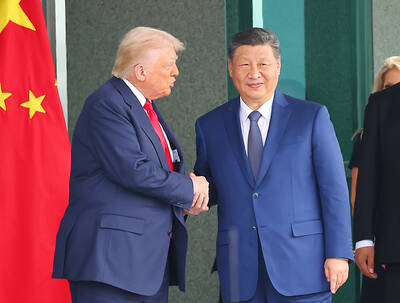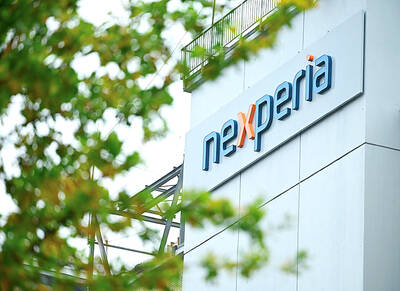Sydney is imposing new taxes on foreigners buying homes, as concerns grow that a flood of mostly Chinese investors is crowding out locals and killing the “Great Australian Dream” of owning property.
Ownership rates across the country are among the highest in developed nations, with having your own house long viewed as a key aspect of Australian identity.
However, as prices rise to record levels — Sydney is ranked second only to Hong Kong as major cities with the world’s least affordable housing — new potential homeowners have been increasingly forced out of the market with foreigners blamed as a key factor.

Photo: AFP
“The governments want to respond to a perception about housing affordability and the impact of foreign investment on that,” KPMG Australia’s indirect tax specialist Michelle Bennett told reporters.
“[Politicians] are raising money from people who aren’t voting, so superficially you can understand that it’s possibly not bad politics,” she added, but warned the measures could be a “blunt instrument” that could hurt the market.
Last year, leading apartment developer Lend Lease Corp sold out more than A$600 million (US$444 million) worth of new units in Sydney’s Darling Harbour in under five hours, with the Australian Financial Review reporting that one-third of buyers were foreign.
Lend Lease said the sale broke local records, but such reports have also fueled calls for government action to protect Australian buyers.
In response, the New South Wales, Victoria and Queensland state governments have introduced or are set to slap new property and land taxes on foreign buyers, sparking an outcry from developers fearful that they will flee to other markets, such as New Zealand and Canada.
“It is very bad. Without the Chinese nothing would ever get built,” Harry Triguboff, the country’s richest man and head of prominent developer Meriton, told the Australian Financial Review this week. “Never mind the bullshit stories, sales volumes have already dropped and prices are coming down steadily. The Chinese buyers are already disappearing.”
Analysts say Australia is an appealing market particularly after Hong Kong and Singapore introduced a 15 percent property tax on non-local buyers and as the Australian dollar weakened against other currencies.
The proposed tax in Sydney’s New South Wales state to be announced this week would be only 4 percent, in Queensland it is 3 percent and in Victoria 7 percent.
The island continent experienced an average 7.25 percent annual housing growth over the past three decades according to the central bank, attracting Chinese investment into commercial and residential real estate.
Chinese invested A$4.2 billion in 2011 to 2012, rising to A$24.3 billion in 2014 to last year according to Australia’s Foreign Investment Review Board, making them the largest overseas buyers.
Housing affordability, and the role of property investors, has been a key battleground ahead of national elections on July 2.
However, with housing prices appearing to be coming off the boil and the economy transitioning away from a mining boom, analysts said the state taxes could backfire.
“It’ll have ramifications down the track when the market goes through a pretty significant downturn in terms of construction and developers are finding it hard to get projects going,” BIS Shrapnel’s managing director Robert Mellor said.
Signs of a softening housing market could also be why states appear to be trying to “grab some revenue while it’s on offer,” leading property data provider CoreLogic’s Australia research head Cameron Kusher said.
Meanwhile, there are question marks about whether current data adequately captures the full extent of foreign investment in Australian real estate, with some statistics not delineating between commercial and residential property purchases.
In one estimate, University of Sydney researchers last year said offshore Chinese purchases only totaled 2 percent of all transactions in 2014 out of overall residential home sales of A$270 billion, the Sydney Morning Herald reported.
Despite the new tax hurdles, Kusher expects long-term Chinese housing investment to continue.
“The people that are buying for the long term... maybe at some point to migrate to Australia, I don’t think it would act as too much of a deterrent for them,” he said.

Nissan Motor Co has agreed to sell its global headquarters in Yokohama for ¥97 billion (US$630 million) to a group sponsored by Taiwanese autoparts maker Minth Group (敏實集團), as the struggling automaker seeks to shore up its financial position. The acquisition is led by a special purchase company managed by KJR Management Ltd, a Japanese real-estate unit of private equity giant KKR & Co, people familiar with the matter said. KJR said it would act as asset manager together with Mizuho Real Estate Management Co. Nissan is undergoing a broad cost-cutting campaign by eliminating jobs and shuttering plants as it grapples

TEMPORARY TRUCE: China has made concessions to ease rare earth trade controls, among others, while Washington holds fire on a 100% tariff on all Chinese goods China is effectively suspending implementation of additional export controls on rare earth metals and terminating investigations targeting US companies in the semiconductor supply chain, the White House announced. The White House on Saturday issued a fact sheet outlining some details of the trade pact agreed to earlier in the week by US President Donald Trump and Chinese President Xi Jinping (習近平) that aimed to ease tensions between the world’s two largest economies. Under the deal, China is to issue general licenses valid for exports of rare earths, gallium, germanium, antimony and graphite “for the benefit of US end users and their suppliers

Dutch chipmaker Nexperia BV’s China unit yesterday said that it had established sufficient inventories of finished goods and works-in-progress, and that its supply chain remained secure and stable after its parent halted wafer supplies. The Dutch company suspended supplies of wafers to its Chinese assembly plant a week ago, calling it “a direct consequence of the local management’s recent failure to comply with the agreed contractual payment terms,” Reuters reported on Friday last week. Its China unit called Nexperia’s suspension “unilateral” and “extremely irresponsible,” adding that the Dutch parent’s claim about contractual payment was “misleading and highly deceptive,” according to a statement

The Chinese government has issued guidance requiring new data center projects that have received any state funds to only use domestically made artificial intelligence (AI) chips, two sources familiar with the matter told Reuters. In recent weeks, Chinese regulatory authorities have ordered such data centers that are less than 30 percent complete to remove all installed foreign chips, or cancel plans to purchase them, while projects in a more advanced stage would be decided on a case-by-case basis, the sources said. The move could represent one of China’s most aggressive steps yet to eliminate foreign technology from its critical infrastructure amid a